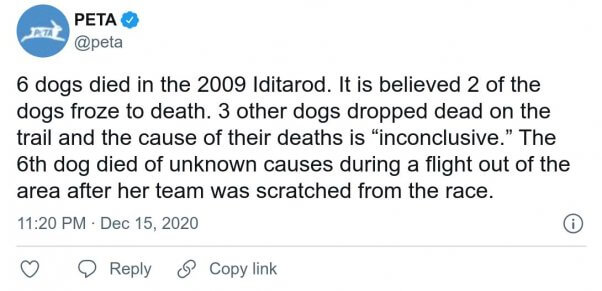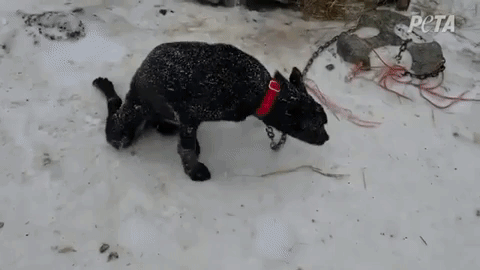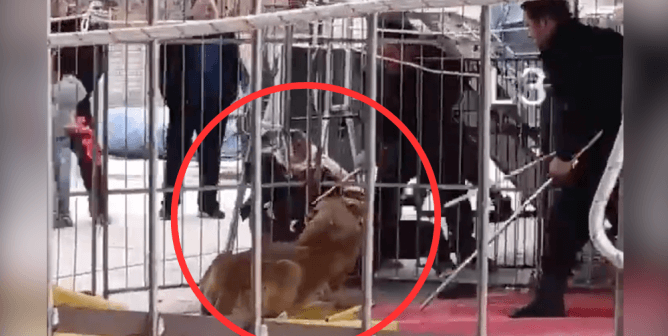You Know the Iditarod Is Killing Dogs, but Do You Know How They’re Killed?
Remember 5-year-old Oshi who died of aspiration pneumonia after her musher, Richie Beattie, forced her to race in the 2019 Iditarod? If human athletes were forced to compete until they died after inhaling their own vomit, there would be dire consequences—people would be jailed. And although Beattie—who was slated to take home the 2019 Iditarod Rookie of the Year Award—was disqualified after the dog’s death (per race rules), Ed Hopkins, the musher who did win the rookie award, announced that he’d be giving the $2,000 prize money to Beattie anyway. A win-win-lose situation, and—as is the norm in the cruel race—it’s the dog who pulled the fatal short straw.
What is aspiration pneumonia, and is it a common cause of death among dogs forced to race in the Iditarod?
There’s a reason why so many refer to the Iditarod as a “death race”—discover six of the most common illnesses and injuries that plague dogs along the event’s trail of suffering:
-
Aspiration Pneumonia
The leading cause of death for dogs made to race in the Iditarod is aspiration pneumonia—caused by inhaling their own vomit. A year before Oshi’s death, after the 2018 Iditarod, a necropsy report found that a dog named Blonde had died from aspiration pneumonia, too. And of those animals who survive the race, 81% are left with lung damage and 61% with gastric ulcers. Mushers are aware of these deaths and injuries—their continued pursuit of the Iditarod prize purse regardless of the known fatal risks shows their complete lack of concern about pushing dogs to and beyond their limits.
-
Asphyxiation
Dogs forced to run in the Iditarod death race have also died of asphyxiation (suffocation), but Dorado’s story is particularly horrifying: In 2013, after being dropped from the race because “he was moving stiffly,” the 5-year-old dog was reportedly buried in snow “in an area set up to care for dogs” and he asphyxiated. According to reports, his dead body was discovered as many as five hours after he was last checked on—a completely preventable death.
-
Wet Lung
On March 15, 2017, two dogs collapsed and died on the Iditarod trail. The necropsy report indicated that one of them—3-year-old Shilling—died as a result of abnormalities that included “extensive pulmonary edema,” caused by excess fluid in the lungs (aka “wet lung,” a serious respiratory condition). The other victim, 4-year-old Flash, reportedly died of aspiration pneumonia, which, as we know, is also caused by foreign substances in the lungs. Shilling’s and Flash’s deaths—the fourth and fifth of 2017, respectively—made the race the deadliest Iditarod since 2009, when six dogs died.
-
Hyperthermia
Also during 2017’s particularly deadly Iditarod, a 2-year-old dog named Smoke died of hyperthermia, or overheating. Smoke was being flown from Galena, Alaska, to Anchorage after being dropped from the race because of an apparent wrist injury when race officials said he “died unexpectedly.”
-
Hypothermia
During 2009’s especially fatal race, Dizzy and Grasshopper—two of the six victims of that year’s Iditarod—reportedly died of hypothermia after they were stuck outside in temperatures that plummeted to minus 45 degrees.

-
Struck by Vehicles
The 2022 Iditarod death race was still more than a month away, but already a dog had been killed: On January 19, a team of dogs forced to race by Jaye Foucher—a musher registered for this year’s Willow 300 and Iditarod races—was hit by a truck, killing one of them (Noddy) and injuring others. The Willow 300 is a qualifying race for the Iditarod.
On March 14, 2017, Groovy—who was dropped from his musher’s team—was reportedly struck by a car and killed after escaping from the home of a handler in Anchorage. In 2016, 3-year-old Nash died after being hit by a snowmobile during the race—three other dogs being forced to race were injured in the same collision. And in 2015, a dog named Stuart got loose and was later hit by a car.
The Iditarod should run itself to death and leave dogs alone.
These causes of death are the ones we commonly see in the Iditarod—they don’t include dogs who have died while being forced to train for the race, those who died while chained up outside in the off-season, or those who were killed because they weren’t fast or fit enough for competition or didn’t meet certain aesthetic standards (e.g., if they had white paw pads). Dogs who finish the race but are no longer useful to the industry may be shot, drowned, or abandoned to starve.
And as a PETA eyewitness investigation into two dog kennels owned by former Iditarod champions showed, even dogs who don’t die on the Iditarod trail or aren’t otherwise killed are still forced to endure widespread suffering and neglect.

No prize is worth a dog’s life or suffering. For Birch, Oshi, Dorado, Smoke, and countless other victims of the Iditarod, PETA will continue to protest the event’s cruelty. We’ll be monitoring this year’s death race closely. Check back here and follow @peta on Twitter for updates.
Sponsor by sponsor, PETA has been taking down the Iditarod—join us in speaking out for dogs.
Injured dogs, missing dogs, dead dogs—it’s no wonder that so many major companies, including Millennium Hotels and Resorts, ExxonMobil, Chrysler, Alaska Airlines, Coca-Cola, Jack Daniel’s, State Farm, and Wells Fargo, have listened to PETA and dropped their Iditarod sponsorships. Tell Liberty Media/GCI to quit dragging its feet and cut its ties, too:




